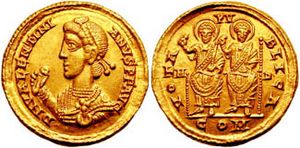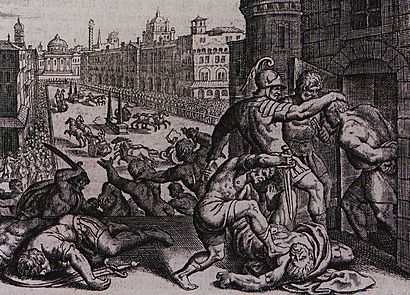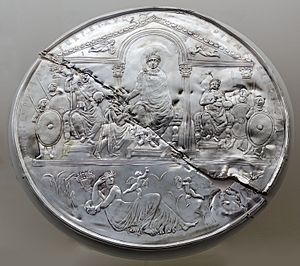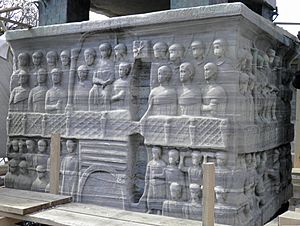Theodosius I facts for kids
Quick facts for kids Theodosius the Great |
|||||
|---|---|---|---|---|---|
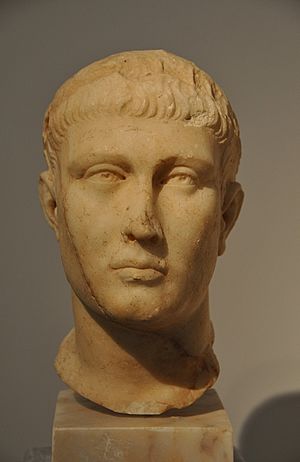
|
|||||
| Roman emperor | |||||
| Augustus | 19 January 379 – 17 January 395 | ||||
| Predecessor | Valens | ||||
| Successor | |||||
| Co-rulers |
See list
Gratian (379–383)
Valentinian II (379–392) Arcadius (383–395) Magnus Maximus (383–388) Victor (384–388) Eugenius (392–394) Honorius (393–395) |
||||
| Born | 11 January 347 Cauca or Italica, in Hispania (present-day Spain) |
||||
| Died | 17 January 395 (aged 48) Mediolanum, Roman Empire |
||||
| Burial | Church of the Holy Apostles, Istanbul, Turkey | ||||
| Spouse |
|
||||
| Issue |
|
||||
|
|||||
| Dynasty | Theodosian | ||||
| Father | Count Theodosius | ||||
| Mother | Thermantia | ||||
| Religion | Nicene Christianity | ||||
Theodosius I (born January 11, 347 – died January 17, 395), also known as Theodosius the Great, was a Roman emperor. He ruled from 379 to 395. He was the last emperor to rule the entire Roman Empire before it was split into two parts: the Western and Eastern empires.
During his time as emperor, Theodosius won an important war against the Goths. He also won two civil wars. He played a big part in making the Nicene Creed the main belief for Christianity. Theodosius was a strong supporter of Christianity. He worked to make sure its main beliefs were followed.
Contents
Early Life and Family Background
Theodosius was born in Hispania (modern-day Spain) on January 11, 347. His father, also named Theodosius, was a very successful general. His mother's name was Thermantia. His family was likely from a noble background in Hispania.
Not much is known about Theodosius's childhood. Some historians believe he grew up with the army. He probably joined his father on military campaigns. This was common for families with a history of military service. He received a good education. He was especially interested in history. He used history as a guide for his own actions later in life.
Military Career and Rise to Power
Theodosius first served with his father in Britain in 368–369. They were there to stop a large invasion. After this, Theodosius got his first independent command in 374. He became a military leader in the province of Moesia Prima near the Danube River.
In 374, he successfully pushed back invaders called Sarmatians. However, his father soon lost favor with the emperor and was executed. Theodosius had to retire to his family's lands in Hispania.
Theodosius did not stay retired for long. The people who caused his father's downfall were removed from power. Emperor Gratian then brought Theodosius's family back into important government roles. By 377, Theodosius was back in command.
In 378, the Eastern Roman emperor Valens was killed in the Battle of Adrianople against the Goths. This was a terrible defeat for Rome. Many Roman military leaders died. Theodosius was chosen to replace Valens. On January 19, 379, he officially became emperor.
Theodosius's Reign as Emperor
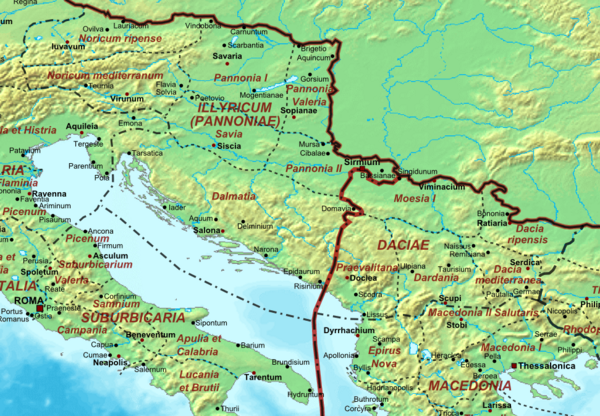
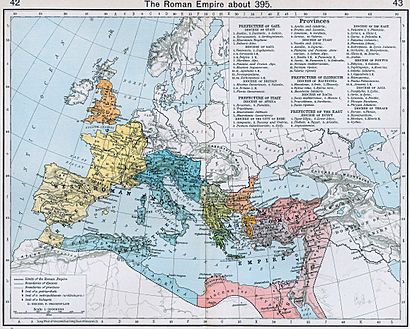
When Theodosius became emperor, his biggest problem was the Goths. They were attacking the Balkans. The Roman army was much smaller after the Battle of Adrianople. Theodosius had to find new ways to get soldiers. He even recruited farmers and miners. He also allowed many non-Roman fighters, including Goths, to join the army.
War Against the Goths (379–382)
Theodosius and his generals won some small battles against the Goths. But they also faced defeats. Theodosius became very ill in 380. After he recovered, he decided to be baptized as a Christian.
By November 380, the situation was stable enough for Theodosius to move his court to Constantinople. In January 381, a Gothic leader named Athanaric visited him and surrendered. Theodosius gave Athanaric a grand funeral when he died. This showed the Goths that the Empire was open to making peace.
Finally, on October 3, 382, Rome and the Goths made a peace agreement. The Goths were allowed to settle on Roman land south of the Danube River. They could keep their own leaders. This was a very good deal for the Goths. They fought for Rome as a separate group, not fully integrated into the Roman army.
Political Challenges (383–387)
In 383, Theodosius made his oldest son, Arcadius, a co-emperor. This was a way to secure his family's power. Around this time, a new emperor, Magnus Maximus, rose to power in Britain.
In August 383, Emperor Gratian was killed during Maximus's rebellion. Theodosius could not fight Maximus right away. His army was not strong enough. So, he started talks with the Persian Empire. He also tried to stop Maximus's ambitions.
In 384, Theodosius met with his co-emperor Valentinian II. They made a peace deal with Magnus Maximus. This peace lasted for several years. Theodosius wanted his two sons to inherit half of the empire each. This led to some problems in the Western Empire.
Theodosius's second son, Honorius, was born in 384. Theodosius's first wife, Aelia Flaccilla, died around 386. His daughter, Pulcheria, also died in 386.
In 386, more Goths were defeated and settled in Roman territory. Work also began on a large column in Constantinople. This column was built to celebrate Theodosius's victories.
In 387, there was an uprising in Antioch. The Roman–Persian Wars ended with a treaty. This treaty divided the ancient Kingdom of Armenia between the two empires.
Civil War and Victory (387–388)
The peace with Magnus Maximus broke in 387. Valentinian II fled to the east and asked Theodosius for help. Theodosius married Valentinian's sister, Galla.
In 388, Theodosius's armies defeated Maximus at the Battle of Poetovio. Maximus was executed. Theodosius now controlled the entire Roman Empire. He stayed in Milan until 391. He put his own loyal people in important positions in the West.
The Thessalonica Incident (390)
In 390, a terrible event happened in Thessaloniki (Greece). Roman soldiers killed many local people. This was likely a response to a riot. The riot had led to the murder of a Roman official. Theodosius was not in Thessalonica when this happened. He was in Milan. This event has been a dark mark on Theodosius's reputation for centuries.
Second Civil War (392–394)
In 391, Theodosius left his general, Arbogast, in charge of the Western emperor Valentinian II. Theodosius wanted to rule the whole empire from Constantinople. On May 15, 392, Valentinian II died. Arbogast then made Eugenius the new emperor in the West.
Theodosius saw Eugenius's rule as illegal. In 393, he made his second son, Honorius, an emperor. This showed that Theodosius was ready for war. Both sides prepared for battle.
Theodosius gathered a large army. It included Goths and other groups. He marched against Eugenius. The battle began on September 5, 394. Thousands of Goths died. The next day, the battle continued. Theodosius's forces were helped by a strong wind called the Bora. This wind blew against Eugenius's army. Eugenius was captured and executed. Theodosius's victory made him the sole ruler of the entire empire.
Historians used to think this war was a fight between Christians and pagans. But modern scholars say religion was not the main reason for the conflict.
Death and Legacy
Theodosius died in Mediolanum (Milan) on January 17, 395. He was 48 years old. His funeral was held on February 25. Bishop Ambrose praised Theodosius for his support of Christianity.
On November 8, 395, his body was moved to Constantinople. He was buried in the Church of the Holy Apostles. He was later called "the Divine Theodosius."
The Honorific "The Great"
Theodosius was first called "the Great" to tell him apart from his grandson, Theodosius II. Later, at a church council in 451, he was given this title because he strongly supported Nicene Christianity.
Art and Architecture
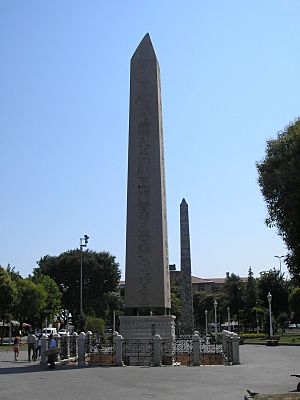
The art from Theodosius's time shows a renewed interest in classical Roman styles. This period is sometimes called the "Theodosian renaissance." The Forum Tauri in Constantinople was renamed the Forum of Theodosius. It was decorated with a large column and a triumphal arch in his honor.
In 390, Theodosius had a huge stone monument, an obelisk, moved from Egypt to Constantinople. This was a very difficult task for the technology of the time. It still stands in the Hippodrome of Constantinople. The base of the obelisk shows carvings of Theodosius and his family. It also shows the amazing engineering feat of moving the obelisk.
Religious Policies
Theodosius was a strong supporter of Nicene Christianity. This belief states that God the Father, the Son, and the Holy Spirit are all equal. He was against Arianism, which had different ideas about Jesus's nature.
In 380, Theodosius issued a law called the Edict of Thessalonica. This law said that only Christians who believed in the equality of the Father, Son, and Holy Spirit were "Catholic." Others were called heretics. This law was mainly for Constantinople. It did not force pagans or Jews to convert. But it was the first Roman law to define a specific Christian belief as correct.
In 381, Theodosius called a meeting of bishops in Constantinople. This meeting, the First Council of Constantinople, confirmed the Nicene beliefs. It also said that the Holy Spirit was equal to the Father.
Paganism and Temples
Theodosius was careful with traditional non-Christian religions. He repeated bans on animal sacrifice and fortune-telling. But he allowed other pagan practices to continue. Temples could stay open. He even supported keeping temple buildings safe. However, some Christian extremists, including his own officials, damaged many holy sites.
Later in his reign, some laws against paganism were issued. But historians now believe these laws did not have a huge impact. There is little proof that Theodosius actively tried to destroy traditional religions. He even appointed pagans to high positions.
Archaeological evidence shows that most temple destruction happened in specific areas. This was often done by officials who went beyond Theodosius's official policy. Many historical writings about widespread temple destruction are not supported by archaeological findings.
Modern scholars believe that paganism slowly declined. It was not violently ended by Theodosius. The Roman Empire in the fourth century had many different religions. They usually co-existed peacefully. While Theodosius's reign was important for the rise of Christianity, he did not completely ban paganism. His efforts to promote Christianity were careful and aimed at keeping peace.
Images for kids
-
Solidus of Theodosius, showing both him and his co-emperor Valentinian II (r. 375 – 392) enthroned on the reverse, each crowned by Victory and together holding an orb victoria augg ("the Victory of the Augusti")
-
Theodosius offers a laurel wreath to the victor, on the marble base of the Obelisk of Thutmosis III at the Hippodrome of Constantinople.
See also
 In Spanish: Teodosio I el Grande para niños
In Spanish: Teodosio I el Grande para niños
- Battle of Frigidus
- De Fide Catolica
- Galla Placidia, daughter of Theodosius
- List of Byzantine emperors
- Roman emperors family tree
- Saint Fana
- Serena, niece of Theodosius and wife of Flavius Stilicho
- Zosimus, pagan historian from the time of Anastasius I


